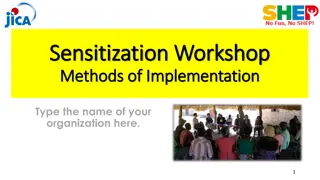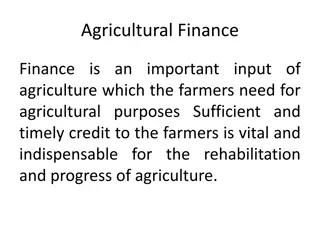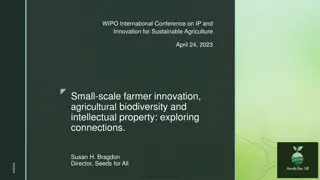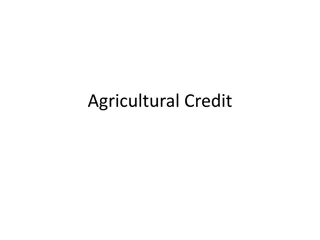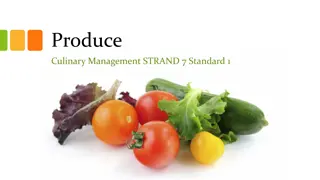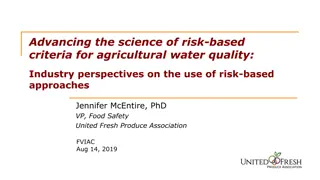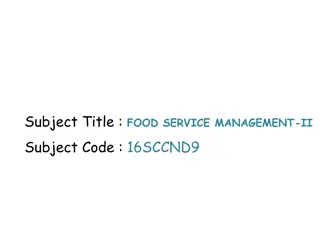Effective Storing Techniques for Agricultural Produce
Fruit and vegetable production varies by region, leading to the need for storage to ensure a continual supply. Different storage methods like natural field storage and controlled atmosphere storage enable longer preservation periods. While natural ventilation serves as a simple storage system, it requires proper airflow management for efficient operation.
Uploaded on Sep 11, 2024 | 2 Views
Download Presentation

Please find below an Image/Link to download the presentation.
The content on the website is provided AS IS for your information and personal use only. It may not be sold, licensed, or shared on other websites without obtaining consent from the author. Download presentation by click this link. If you encounter any issues during the download, it is possible that the publisher has removed the file from their server.
E N D
Presentation Transcript
CERTIFICATE 3 AGRICULTURE ENGINEERING AGE332 INTRODUCTION TO POST HARVEST SYSTEM TOPIC 3: STORING WEEK 4: NOTES
The need for storage Most fruit and vegetable production in temperate areas is seasonal. In contrast, cultivation and harvest periods are much longer in tropical and subtropical areas. Demand is year round and it is normal practice to use storage in order to ensure continuity of supply. Moreover, storage is a strategy for achieving higher returns. Produce can be held temporarily to overcome gluts thus limiting price falls or to address shortage periods when prices are high.
Storing of Farm Produce As a rule, there are many ways of storing a product. The length of storage time can be longer in specifically designed structures. With refrigeration and controlled atmospheres, storage periods can be even longer. The technology utilized depends on whether the benefits (higher prices) outweigh the costs.
Natural or field storage This is the most rudimentary system and is still in use for many crops. For example, roots (carrots, sweet potato, and cassava) and tubers (potato). Crops should be left in the soil until preparation for the market. This is similar to how citrus and some other fruits are left on the tree. Although storing products under natural conditions is widely practiced, it leaves them exposed to pests and diseases as well as to adverse weather conditions. This can have a detrimental effect on quality.
Another method widely used is field storage in heaps. This method ensures that produce is free from soil humidity and is protected from the weather with a tarpaulin, straw, or plastic materials. It is a low cost alternative for bulky crops that require large buildings. For example, potato, onions, pumpkins, sweet potato etc. Field storage in bins is a more recent variation where a pair of them (one on top of the other, the one above protected from the weather) is left in the field. It has the additional advantage of making it possible to undertake mechanical handling later.
Natural ventilation Amongst the wide range of storage systems, this is the most simple. It takes advantage of the natural airflow around the product to remove heat and humidity generated by respiration. Buildings providing some form of protection from the external environment and with gaps for ventilation can be used. Produce can be placed in bulk, bags, boxes, bins, pallets etc Although simple, some key concepts need to be taken into account for the efficient operation of this system.
Differences in internal temperature and relative humidity conditions compared to conditions externally, need to be minimal. What this means is that this system can only be used with crops that store well under natural conditions such as potato, onions, sweet potato, garlic, pumpkins, etc. For adequate ventilation, openings need to be wide. This means they need to be fitted with screens to keep animals, rodents, and pests out. As with any other type of fluid, air follows the path of least resistance. This means that if product is stored in a compact mass, air will circulate to remove heat and gases which have accumulated as a result of respiration. Efficient ventilation requires adequate space. However, this reduces storage capacity.
Hot and humid air rises within the storage facility. If no ventilation gaps exist, this leads to the build up of hot and humid areas which in turn affects the quality of stored goods. This presents the ideal conditions for the development of disease. Within certain limits, it is possible to take advantage of natural changes in temperature and relative humidity.
Natural ventilation Storing garlic in shelters with natural ventilation.
Forced air ventilation Heat and gas exchange can be improved provided air is forced to pass through the stored product. This system allows for more efficient utilization of space for bulk storage. Air conducts run under a perforated floor and air is forced through the product. Again, as air follows the least resistance path, loading patterns as well as fan capacity and conduct dimensions should be carefully calculated. This is to ensure that there is uniform distribution of air throughout the product.
Forced air storage facilities. Product is piled up to the yellow line. Air from the floor openings is forced to pass thought the stored mass. An inspection alley is located on the upper right hand side with ladders to sample product during storage.
Inside of a forced air storage facility. Air conducts are removed and empty space is used to shelter farm machinery and equipment when there are no products in storage.
Refrigeration Cold storage is the one widely practiced method for bulk handling of the perishables between production and marketing processing. It is one of the methods of preserving perishable commodities in fresh and whole some state for a longer period by controlling temperature and humidity with in the storage system. Maintaining adequately low temperature is critical, as otherwise it will cause chilling injury to the produce. Every crop has an optimal combination of temperature and relative humidity for storage.
Also, relative humidity of the storeroom should be kept as high as 80-90% for most of the perishables, below (or) above which his detrimental effect on the keeping quality of the produce. Most fruits and vegetables have a very limited life after harvest if held at normal harvesting temperatures. Postharvest cooling rapidly removes field heat, allowing longer storage periods.
Advantages of Cooling Post Harvest Produce Proper postharvest cooling can: Reduce the activity of microorganisms responsible for quality deterioration Reduce internal water loss and wilting; Slow or inhibit the growth of decay-producing microorganisms; Reduce the production of the natural ripening agent, ethylene.
In addition to helping maintain quality, postharvest cooling also provides marketing flexibility by allowing the grower to sell produce at the most appropriate time. Having cooling and storage facilities makes it unnecessary to market the produce immediately after harvest. This can be an advantage to growers who supply restaurants and grocery stores or to small growers who want to assemble truckload lots for shipment. Postharvest cooling is essential to delivering produce of the highest possible quality to the consumer
Benefits of Cold Storage Cold storage can be combined with storage in an environment with added of carbon dioxide, sulfur dioxide, etc. according to the nature of product to be preserved. The cold storage of dried/dehydrated vegetables in order to maintain vitamin C, storage temperature can be varied with storage time and can be at 0 -10 C for a storage time of more than one year, with a relative humidity of 80-95 %.
Benefits of Cold Storage The cold storage of perishables has advanced noticeably in recent years, leading to better maintenance of organoleptic qualities, reduced spoilage, and longer shelf lives.
These advances have resulted from joint action by physiologists to determine the requirements of fruit and vegetables, and by refrigerating specialists to design and run refrigerating machines accordingly.
Refrigerated Rooms Refrigerated space depends on the maximum storage volume. Other factors to be considered include walkways and aisles to handle the product mechanically and the additional space to ensure uniform distribution of cold air. Chamber height depends on product and stacking pattern: three meters for hand stacking but more than six may be required if forklifts are utilized.
Refrigerated rooms can be made with concrete, metal, wood, or other materials. All external surfaces should be thermally insulated, including the floor and ceilings. Type and thickness of insulation material depends on building characteristics, produce to be stored and the difference in temperature required between external and internal conditions. Polyurethane, expanded polystyrene, cork and other such materials can be used as insulation materials. A vapor barrier should be placed on the warm side of the insulation material.








